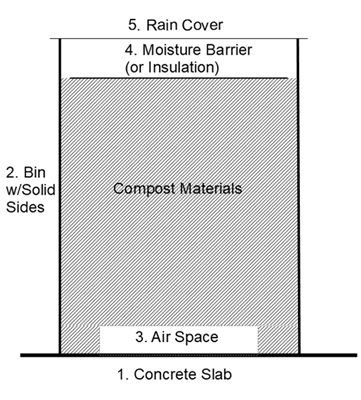 See to the right a cross section of what I believe can be deemed a proper compost bin. I struggle to understand why such a concept is not commercially available, and can only conclude that too few people care about composting, saddest of all even the bin manufacturers. That will change one day, I promise.
See to the right a cross section of what I believe can be deemed a proper compost bin. I struggle to understand why such a concept is not commercially available, and can only conclude that too few people care about composting, saddest of all even the bin manufacturers. That will change one day, I promise.
Most ground-level [so-called] compost bins can be converted into something that approaches proper, the glaring exception being tumblers, which one day I intend to prove are the worst bins ever conceived - deceptive junk on stands. Below is a discussion of the attributes of a proper compost bin, followed by an illustrated guide to converting a "rabbit pen" style bin into a proper compost bin.
- Concrete Slab
- A non-slip surface is best.
- No mud or dirt to clean from your shoes.
- No soil compaction.
- Soil organisms need not enter pile; they are already present or will find their way in; earthworms do not have teeth and are a sign that the pile has sat undisturbed for too long.
- A slab is the preferred surface for the Red Hook Community Farm's Compost Operation (Brooklyn, New York).
- Bin w/Straight, Solid Sides That Is Portable And Durable, Easy To Remove From The Compost Materials, Will Not Sag,
- Portability makes sense; something too heave to move easily does not.
- Durability is strike number one against shipping pallets or even a well-built wooden structure.
- Straight sides make sense; sloped sides do not.
- Solid sides retain moisture.
- That holes in the sides of bins provides ventilation is a myth.
- Openings serve only to dry the outer materials and render them inert.
- Easy to remove from the pile is SO important. This rules out pallets, cinder blocks, anything heavy.
- Will not sag - this rules out chicken wire. And run, fast, from anyone who suggests chicken wire as a bin material. It is AWFUL. If you like wire fencing, I recommend 2" x 4" material. You will need small bolt cutters; wire cutters simply will not cut it ha ha.
- Openings allow materials to leave the bin during a stir, making a mess.
- Trap doors at the base of Soil Savers and Earth Machines and Blackwalls do not work other than to trap the consumer into believing the deceptive staged photos. My name for that style of bin is the Bendover Bin. It is left as an exercise for the reader to figure out why I chose that name.
- Air Space
- An active compost pile is analagous to a fire in a fireplace.
- Both consume oxygen and generate heat.
- Warm air rises drawing fresh air into the reaction area.
- Elevated materials allow air to flow into the reaction area from the bottom, resulting in more complete combustion than if materials were not elevated.
- That is why logs in a fireplace are elevated, and why materials in a compost bin should be, too.
- A layer of brushy material is bad advice - do you want "partially composted brushy material" or "finished compost"? Someone stated this years ago and it has been wrongly repeated ad nauseum.
- A sensible air space is only described in a few books.
- Jim McNelly invented the Compost Aeration Mat described in the Harmonious Technologies book. His invention did not gain acceptance and is but a memory, not a trace of it on the web.
- Moisture Barrier (or Insulation?)
- Slows the escape of moisture from the pile.
- Pile organisms appreciate having a blanket, just as you and I do.
- Insulation would retain moisture and also retain heat. Is there a measurable benefit? I do not have the answer but hopefully one day enough people will care about composting that a research team will conduct controlled experiments and determine an answer.
- Rain Cover - If you were cooking rice would you want another cook to add water? Of course not. Composting is the same...start with the proper amount of moisture (Ideal Watering System) and induce a controlled, slow dry-out. Any source that advises allowing rain to fall on the pile is baseless and illogical.
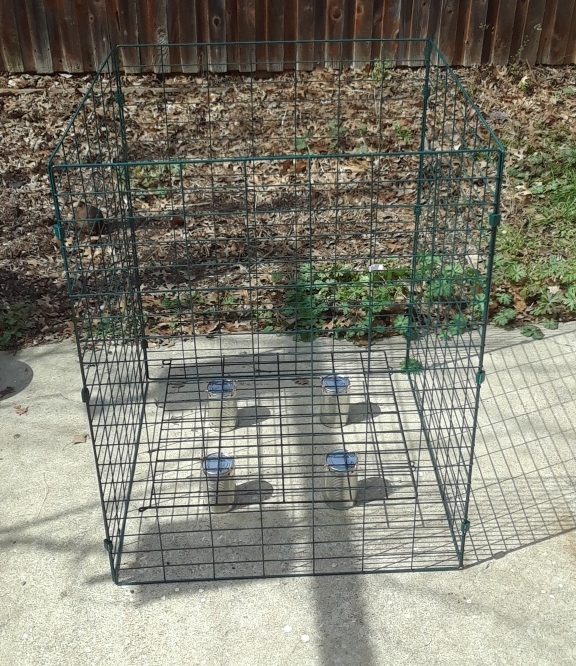 To the right see the stock bin with improvement #1 - a structure to create an air space at the base of the pile.
To the right see the stock bin with improvement #1 - a structure to create an air space at the base of the pile.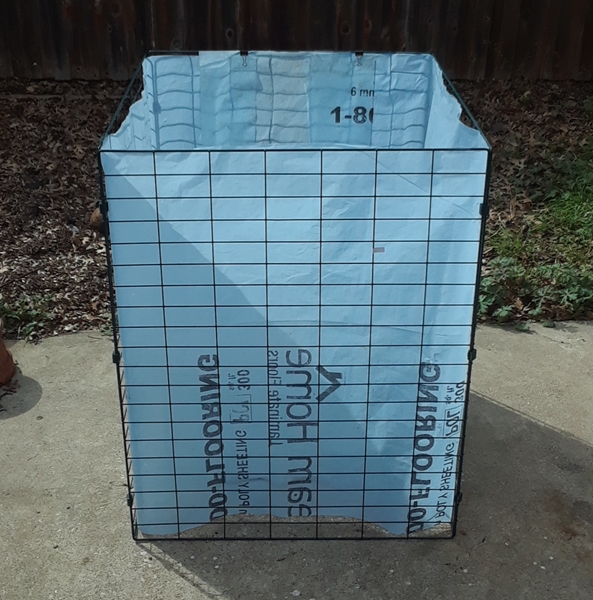 Enhancement #2a - Plastic sheeting to create solid sides.
Enhancement #2a - Plastic sheeting to create solid sides.
If you use flimsy plastic, it must be held in place. Note the two binder clips at the rear of the bin. The front and sides are held up with clear packing tape.
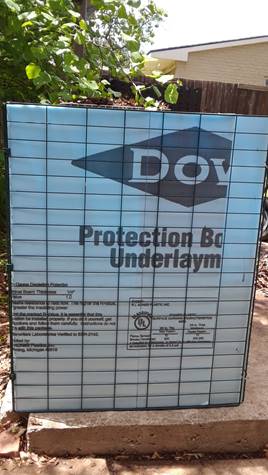 Enhancement #2b - Floor insulation.
Enhancement #2b - Floor insulation.
This material is more well behaved than plastic sheeting, and provides an R value, which in theory helps things decompose more quickly.
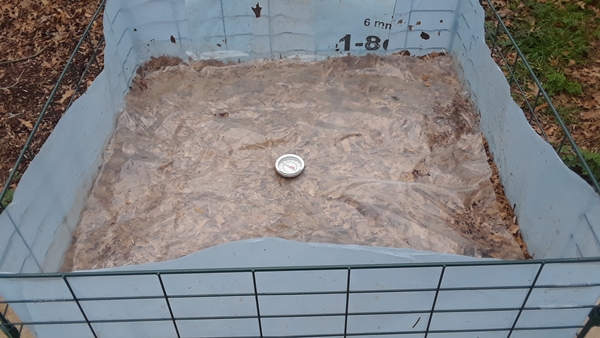 Enhancement #3 - The moisture barrier installed, a simple plastic square.
Enhancement #3 - The moisture barrier installed, a simple plastic square. Enhancement #4 - Rigid foam insulation.
Enhancement #4 - Rigid foam insulation.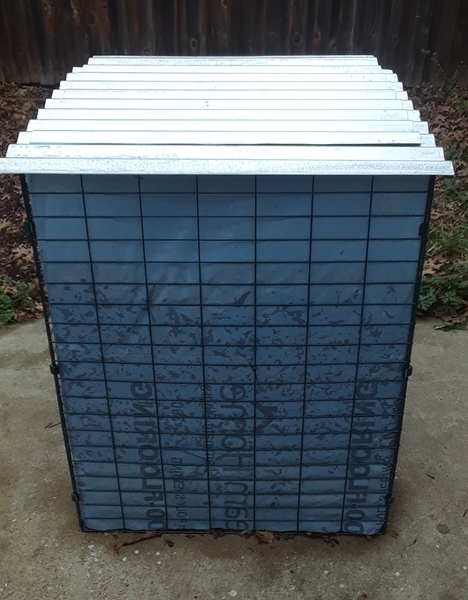 Enhancement #5 - A rain cover. I found corrugated steel roofing to be a good material for this job.
Enhancement #5 - A rain cover. I found corrugated steel roofing to be a good material for this job.| Previous - "Food Preparation" | Next - "The Composting Hall of Shame" |
Next